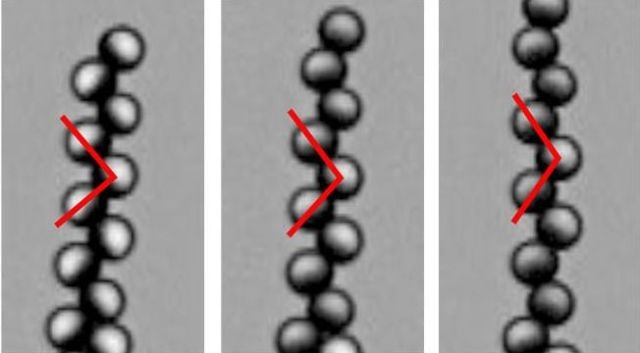Jul 20 2016
Thanks to the ordering effects of two-faced magnetic beads, they can be turned into useful tools controlled by a changing external magnetic field
 Transformation of particle clusters while exposed to an oscillating external magnetic field.
Transformation of particle clusters while exposed to an oscillating external magnetic field.
Janus was a Roman god with two distinct faces. Thousands of years later, he inspired material scientists working on asymmetrical microscopic spheres—with both a magnetic and a non-magnetic half—called Janus particles. Instead of behaving like normal magnetic beads, with opposite poles attracting, Janus particle assemblies look as if poles of the same type attract each other. A new study reveals that the dynamics of such assemblies can be predicted by modelling the interaction of only two particles and simply taking into account their magnetic asymmetry. These findings were recently published in EPJ E by Gabi Steinbach from the Chemnitz University of Technology, Germany, and colleagues at the Helmholtz-Zentrum Dresden-Rossendorf. It is part of a topical issue entitled "Nonequilibrium Collective Dynamics in Condensed and Biological Matter." The observed effects were exploited in a lab-on-a-chip application in which microscopic systems perform tasks in response to a changing external magnetic field.
Initially, the authors experimentally investigated large assemblies of these microbeads with an optical microscope. They then performed numerical simulations based on a simple model featuring off-centred magnetic dipoles, and performed a detailed comparison of both experimental and simulation approaches. Under an oscillating field, the particles continuously revert back to standard magnetic behaviour where the North magnetic poles of particles point towards other particles’ South poles; and this behaviour has been confirmed for as few as two particles.
The authors concluded that the interactions between the off-centred dipoles with the changing external magnetic field transform larger particle clusters into different configurations. For example, they found that staggered bead chains continuously expand to spontaneously form linear chains. This could be harnessed, for instance, to create a zipper-style micro-muscle on a chip; here a staggered chain repeatedly expands and contracts depending on the intensity of the applied field.